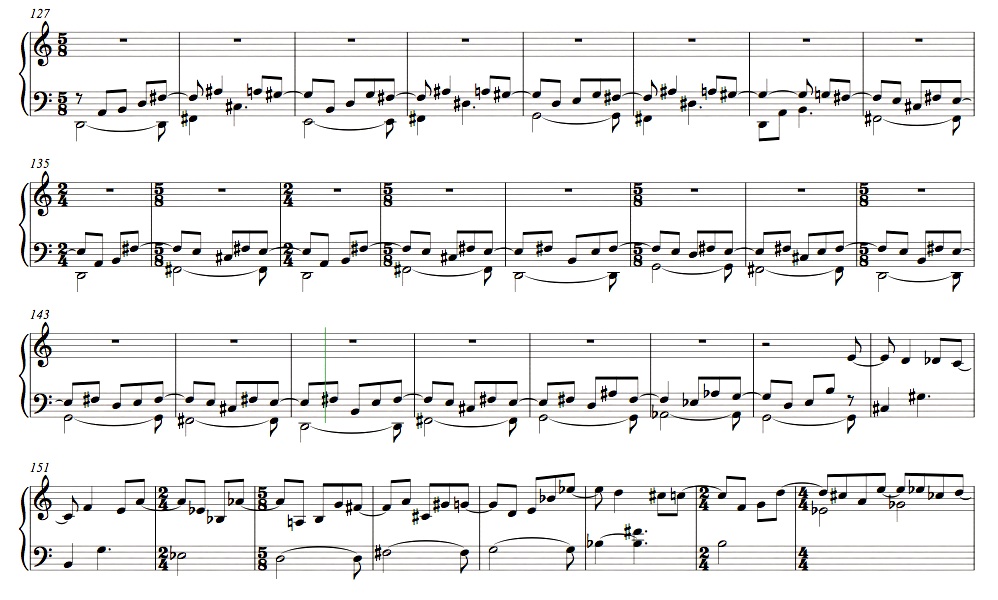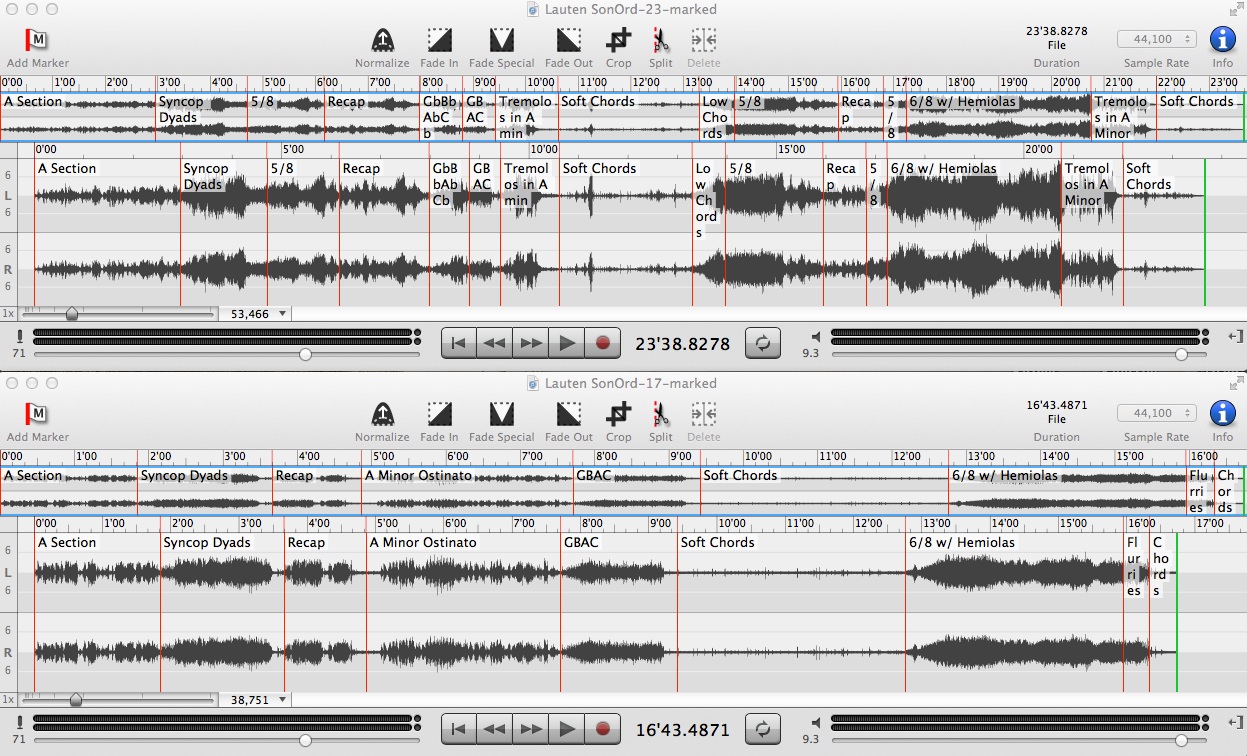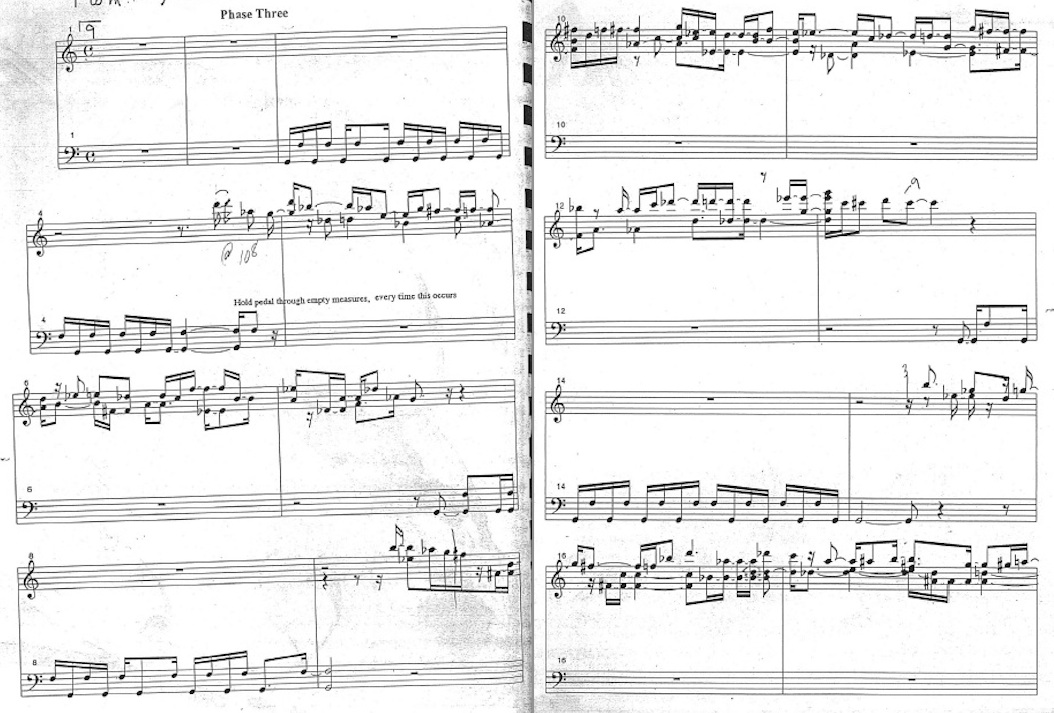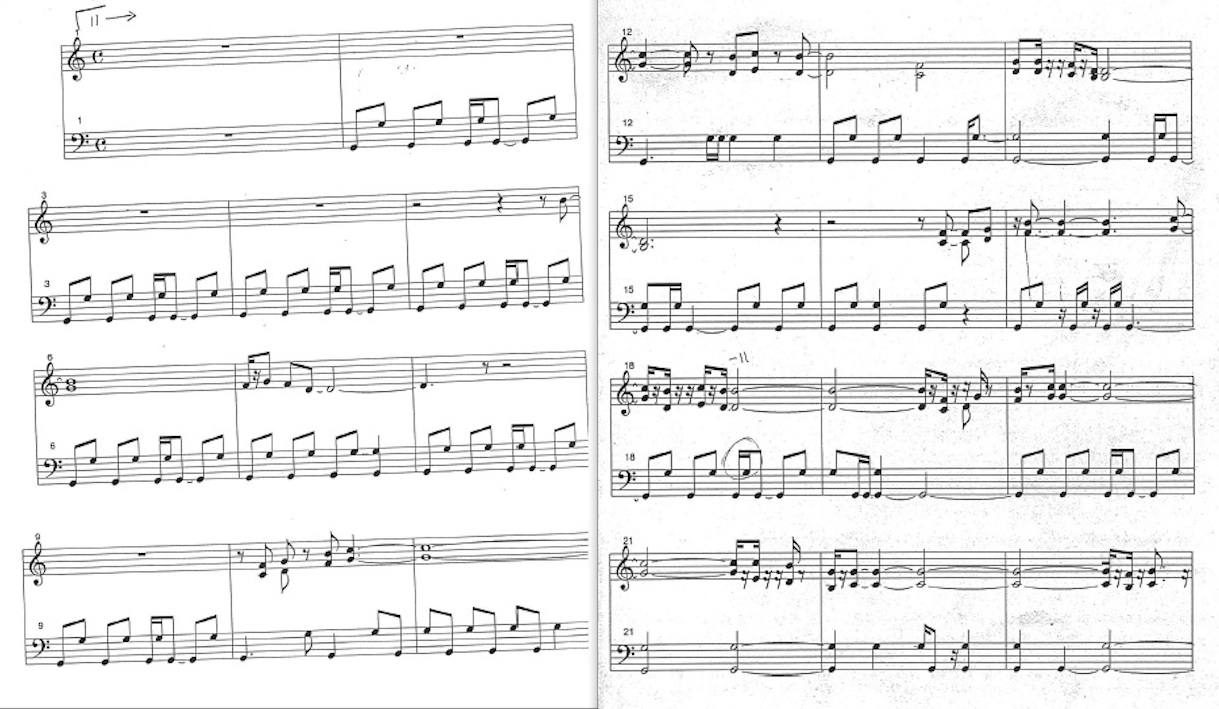Elodie Lauten as Postminimalist Improviser Delivered to the Minimalism Conference in Helsinki, September 2015
By Kyle Gann
Elodie Lauten was born in Paris in 1950, moved to the US in 1972, and tragically died all too young on June 3, 2014. The daughter of the jazz pianist and drummer Errol Parker, she studied piano at the Paris Conservatoire at age seven, and started composing at age twelve. In New York in 1973, she responded to an ad in the Village Voice, and ended up as lead singer for a band called Flaming Youth. She shaved her head, long before that was a common fashion statement. Flaming Youth's guitarist Denise Filiu was living at the time with the famous poet Allen Ginsburg, who also took Elodie in and gave her a Farfisa organ so she could accompany him when he sang and chanted. She studied with La Monte Young, whose Well-Tuned Piano her keyboard music occasionally brings to mind. Despite these radical beginnings, Elodie poured the creative energy of her later years into the forms of opera and oratorio, beginning in 1985 with The Death of Don Juan, and including such large works as Deus ex Machina, Orfreo, and Waking in New York, this last based on Ginsburg poems that he had selected for her. Just before her death she was awarded the Robert Rauschenberg Award, the money from which she used to stage a new performance of Waking in New York. She was too ill to attend it, and died the next day.
Extremely versatile, Elodie was also an excellent pianist. Most of her early recorded pieces, with and without electronics, were things she improvised on piano: Cat Counterpoint, Adamantine Sonata, Sonate Ordinaire, Sonate Modale, Variations on the Orange Cycle, Imaginary Husband, Concerto for Piano with Orchestral Memory. In order to get some perspective on her as an improviser, I have focused this paper on two of her piano works for which we have more than one recording: Sonate Ordinaire and Variations on the Orange Cycle. Both works are recorded on a CD titled Piano Soundtracks on the 4-Tay label. On the CD, Sonate Ordinaire is listed as being a live performance at Jon Schaefer's New Sounds Live series at Merkin Hall in New York, from December 14, 1986. I was at that concert and reviewed it, having just started my new job at the Village Voice only a few weeks before. But many years ago, Elodie also gave me a cassette tape of Sonate Ordinaire, which is noted on the cover as having been recorded by Jon Schafer. The CD version is Sonate Ordinaire lasts 23 and a half minutes; the cassette version lasts only 17 minutes and is very different. That too is annotated as being produced by John Schaefer and broadcast live from Merkin Hall, but it is clearly a different recording. John and I put our heads together but couldn't figure out how two such different versions of the piece were marked as apparently the same performance.
The primary material of the Sonate Ordinaire (and I call it primary because it returns several times in both versions with the feel of a recapitulation, or the A section of a rondo) is very chromatic melody with syncopations and repeated notes over a left-hand sequence of rising or falling minor thirds. I'll play the opening passage of the 23-minute version of Sonate Ordinaire from the CD.
Now I'll play the opening passage from the 17-minute cassette. Or what I have as the opening: for some reason the tape starts in mid-note with a slight glissando, as though someone had turned the tape recorder on after she already started playing, so there's no telling how much of the performance might be missing. However, this passage sounds very much like the other recording overall, although there are a few more repeated notes, and the treble-register interruption before the perpetual motion starts up again is quite different.
I had hoped, upon starting this project, that I might succeed in transcribing a full performance version of the Sonate Ordinaire (as I did for Dennis Johnson's November and Harold Budd's Children of the Hill for the 2009 conference), but it turned out to be too difficult. There are too many passages in which she is playing rapid chromatic lines in the bass, or dissonant tremolos, and deciphering the notes would be extremely time-consuming, with little confidence in the fidelity of the result. But I went as far as I reasonably could with the 23-minute version. The second section of the piece features syncopated dyads (mostly dotted quarters) over a chromatic bass (see mm. 73-86 above in ex. 1).
This is followed by a passage that sounds like quite distinct quintuple meter:
Six minutes in this leads to a recapitulation of the opening material which lasts for almost a minute, and then returns to 5/8 meter. The cassette version contains the second of these passages in a version that sounds remarkably like the CD version, but it omits the passage in quintuple meter, and ascends rather precipitously to start the recap after only three and a half minutes.
The 17-minute version then goes into a simple section with a rhythmic ostinato in 4/4 and a melody in a minor key. There is no counterpart to this in the CD version. Both versions have a passage in which syncopated dyads are played over a simple GBAC ostinato, although in the 17-minute version the ostinato often goes GBFA. In the 17-minute version this passage segues into a three-minute passage of soft chords. The CD version goes into a passage of tremolos in A minor, and then the soft chords. In the cassette version the chords are rather clocklike in rhythm, and contain fewer pitches; in the CD version they are played with more rhythmic expressivity. The following chart shows a comparison of the two recorded versions of Sonate Ordinaire, with each section loosely labeled so that the parallels and differences are clear:
One can see that the 17-minute version lacks the 5/8 section before the recapitulation (and the partial repetition of that section that comes later), and contains instead a long passage on an ostinato in A minor following the recapitulation. The passage on the G-B-A-C ostinato in the 23-minute version is considerably lengthened in the 17-minute version.
* * * * * * * * * * * * * * * * * *
With Variations on the Orange Cycle we're on much clearer ground and know what we're dealing with. Elodie performed the piece in 1991, and later released the recording on 4-Tay. In 1995, pianist Lois Svard asked Elodie for something she could play. Elodie improvised Variations on the Orange Cycle again on a MIDI keyboard, recording what she played into notation software. She then gave Lois the notated score, but as any of you will imagine who have tried this, the notation was so complex that Elodie had to take it back and edit it considerably. Most interestingly, while Elodie's own performance was continuous and almost 40 minutes long, the piece she gave Lois was divided into four movements, each one coming to a full close, and adding up at about 25 minutes. So we have two versions of this piece, both approved by the composer, one in movements and one continuous; one notated and the other recorded as improvisation.
By this point Elodie was writing in a system called Universal Mode Improvisation, or "universal correspondence systems," by which she correlated musical keys, scales, and rhythmic patterns with the hexagrams of the I Ching, the astrological signs, Indian Vedic cosmologies, and so on. I can't say I ever really understood it. It seemed to evoke intuitive responses in her rather than determine anything definite. In one piece for electronic keyboards, Tronik Involutions, she had movements in all twelve keys with various rhythmic styles, and that made a certain amount of sense.
What Elodie wrote herself was that "the starting point for the Variations was the determination of a correspondence with the 'Earth Tone' in its 24-hour cycle frequency, represented by the vibration of the color orange or the fraction F/G [that is, a left-hand drone on F and G], which is the basic theme to the Variations." There are several earth tones, she explains elsewhere; there is one for the earth's revolution around the sun, for instance, and there is one for the earth's daily rotation, 24 hours, which, taken up many, many octaves, turns out to be a G. The four phases in the notated version of the piece, she writes, "are different treatments of the G fundamental: modal (phases 1 and 4), chromatic (phase 2) and polytonal (phase 3)."
We will look first at Lois's notated version of the Variations. Phase 1 (movement 1) is entirely in G mixolydian scale with no sharps or flats. The drone is held by a G and F in the left hand, to which a D is added later. The right-hand melody moves with a subtle attention to upper and lower climax notes in successive phrases.
Phase 2, which Elodie describes as "chromatic," is once again over a G-F drone. The melody this time is mostly in a C harmonic minor scale, giving the entire movement a sense of being a long dominant preparation. Pitches Bb, and less often F# and Db, provide moments of bitonality, especially of Eb-major in first inversion. There is an emphasis on sixths in the right hand, with chromatic movement in the middle voice coloring the harmony. The tonality sounds very much like that of Arvo Part's Fratres and some of his other works, and I think here the position that Elodie is not one of the holy minimalists becomes impossible to sustain on purely stylistic grounds.
Phase 3, described by Elodie as "polytonal," once again uses mostly a G-F seventh as its drone, though in three extended passages the left hand begins moving among different different bass notes harmonized with the fifth and seventh, on the pitches Eb, E, F, Gb, Ab, and occasionally B and D. The right hand is very chromatic and emphasizes fourths (perfect, diminished, and augmented). At the beginning, where the music alternates between left and right hands, there is an emphasis on black keys in the right-hand thumb; when the left hand moves to different bass notes, there is an inconsistent tendency for the right hand to move to the diatonic scale of the bass harmony, so polytonal here doesn't really mean that two keys are sustained at the same time.
Phase 4 is in three sections, of which Elodie's description of "modal" only applies to the second. The first uses a rhythmic ostinato on octave Gs without the F, while the melody stays mostly in G mixolydian with altered notes as chromatic auxiliaries, largely in parallel fifths and always resolving to the G scale. The second section is faster, entirely in G mixolydian, and with a perpetual motion of 8th notes in each hand. The final section reverts to the harmonic motion of Phase 3, with the left hand sometimes moving to other keys, and with interruptions at which G-D-G fifths are played in the treble.
In the passage from about 19 to 28 minutes, Elodie's improvised version departs from anything that ends up in Lois's version later, much of it concerned with the Sonate Ordinaire material. Also, she fuses the material of the two pieces by applying the chromatic sequencing used on the minor third and major second on Sonate Ordinaire to the drone sevenths of the Variations.
These examples of very different realizations of pieces with the same title tell us much about Elodie's creative mind and working method. Although she composed many ensemble works in conventional notation, improvising was a comfortable way of composing for her, and she considered a piece finished after she had played it, with notation not necessary. Her pieces evolved as she played them, gaining or losing sections. Though not written down, her pieces have a strong sonic identity. Like La Monte Young who was briefly her mentor, she conceived of melodic and harmonic relationships that have a recognizable identity but can be improvised around according to extendable patterns. Sometimes the complex is wedded to a particular harmonic area, and sometimes not. The core material of Sonate Ordinaire, with its chromatic melody over a chromatic sequence of rising minor thirds, can start at any pitch level, and there are no obvious correspondences in this material between the two versions, although in other parts of the piece there are keys like G major and A minor that seem reserved for certain figurations. That Elodie could separate a piece out into four separate phases to give it to another pianist, and smoothly move back and forth among those phases in her own performance, points to a compositional mind both systematic and flexible.
We have her recordings. I don't know what state her archives are in, or where they are being held; Kenneth Hamrick, who wrote her obituary for New Music Box, seemed to be in charge of that, but hasn't responded to a query I sent him. I do hope that there are other people committed to keeping her music alive. With the operas it will be easier, as there are full scores and a performance tradition. With the piano works, it may take someone who's got great ears and infinite patience to make it possible for another pianist to replicate them. These are very important and beautiful works, and I do hope it is possible to ensure them a permanent place in the historical repertoire.
Copyright Kyle Gann 2015
Return to the Kyle Gann Home Page
If you feel moved to reply to any of this, email me











